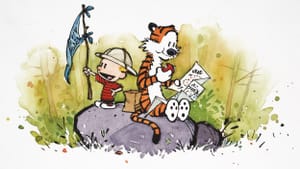Stay in the Loop
BSR publishes on a weekly schedule, with an email newsletter every Wednesday and Thursday morning. There’s no paywall, and subscribing is always free.
Happy birthday, Mr. Watterson, wherever you are
Bill Watterson: An introvert's appreciation

Bill Watterson isn’t just the creator of the world’s best comic strip. According to the book Looking for Calvin and Hobbes, a biography of the elusive and reclusive cartoonist, Watterson is also a world-class introvert.
Watterson refuses to make public appearances, give interviews, or talk to fans, although he sometimes responds to fan mail and occasionally corresponds or collaborates with fellow cartoonists. Family and friends have been instructed not to reveal where he lives. (For years, he had an unlisted number and lived under his wife’s maiden name.) There’s just one, early, photo of him available to the public: It shows a dorky looking dude seated at a drawing table.
Apparently, Watterson, like J.D. Salinger and Thomas Pynchon, is one of those very smart, very creative people who just want to be left alone. He doesn’t want to be the life of the party. He doesn’t even want to go to the party. He wants to stay home and get on with his work.
Fame, for these folks, isn’t a perk. It’s an ordeal.
An introvert is “a person who is energized by being alone and whose energy is drained by being around other people.” Introverts enjoy exploring their own thoughts and feelings. Being with people, even people they are comfortable with, interferes with their desire to be “quietly introspective.“
For instance?
Although Watterson won the Harvey Award for Best Syndicated Comic Strip seven years in a row, from 1990 to 1996, he never once showed up to claim his award and accept the acclaim of his peers. “From most reports and reported anecdotes,” says fellow cartoonist Berkeley Breathed, with affection, “he is most assuredly a serious whack job.”
Or just a serious introvert.
As he worked on the strip, the man had no need (and even less desire) to leave the house seeking acclaim or inspiration. Everything he needed was inside his own head.
Not for sale
Watterson, famously, also refused to sell out.
He wouldn’t agree to license or merchandise “Calvin and Hobbes.” When pressured to do so by the syndicate, he threatened to stop drawing the strip altogether. After several years of wrangling, the syndicate backed down and handed control of his creation back to the artist.
About the millions he passed up by refusing to merchandise the strip? “The so-called opportunities I faced,” he once said, “would have meant giving up my individual voice for that of a money-grubbing corporation. It would have meant my purpose in writing was to sell things, not say things.”
Watterson gave us, in all, a total of 3,160 Calvin and Hobbes strips. He also gave us an instructive example of one way to live, with integrity, a creative life.
“He doesn’t get his kicks from being famous.” his mother once said in an interview. “He was just doing something he enjoyed doing. He definitely wants to disappear.”
Nearly 20 years after that last strip — mission accomplished. Today, nobody knows where the guy is or what he’s up to.
Nicely done, Mr. Watterson, On behalf of fellow introverts everywhere, I salute you.
For Alaina Mabaso's appreciation of Bill Watterson, click here.
What, When, Where
Exploring Calvin and Hobbes. Through August 3, 2014, Robinson Gallery, Billy Ireland Cartoon Library & Museum, The Ohio State University. Sullivant Hall, 1813 N. High Street, Columbus, Ohio. http://cartoons.osu.edu/events/exploring-calvin-and-hobbes/
Looking for Calvin and Hobbes: The Unconventional Story of Bill Watterson and His Revolutionary Comic Strip by Nevin Martell. Bloomsbury Academic, revised edition 2010.
Sign up for our newsletter
All of the week's new articles, all in one place. Sign up for the free weekly BSR newsletters, and don't miss a conversation.
 Roz Warren
Roz Warren